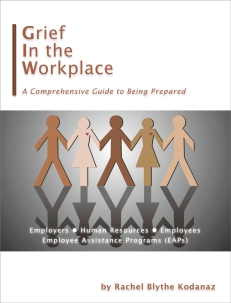 As I stood at the podium presenting a training on Grief in the Workplace recently, I was asked a question that made me ponder enough to write a blog on the subject. Should divorcees be granted bereavement leave in order to get their affairs in order? My first reaction was how could I answer this question in a way that I support both grievers mourning the loss of a relative and those who are grieving the end of a marriage? Carefully.
As I stood at the podium presenting a training on Grief in the Workplace recently, I was asked a question that made me ponder enough to write a blog on the subject. Should divorcees be granted bereavement leave in order to get their affairs in order? My first reaction was how could I answer this question in a way that I support both grievers mourning the loss of a relative and those who are grieving the end of a marriage? Carefully.
Most companies grant a 3-7 day bereavement leave to attend a funeral and take care of initial obligations, including the planning of the funeral, attending the funeral and the need to express grief without the burden of co-workers, management and business needs. The interesting part of the bereavement leave policies is that it does not take into consideration the additional tasks to be accomplished in the coming months. In other words, the policy is truly designed for the initial days off following the loss.
So what happens when you go home one evening and your spouse tells you that s/he is filing for divorce. You are blindsided by the news, and experience similar shock as one who has lost a loved one. Should the company provide 3-7 days off as the employee mourns the loss? It’s an interesting question indeed, and is a slippery subject for me to comment on. However, shock is shock and the ability to work under those circumstances is extremely difficult.
As I have spent the last 20 years answering company questions on how to handle grief in the workplace, the most sought out advice is the Bereavement Leave Policy. Current polices are less effective in the 21st century as most of us live far away from family when a death occurs. Making arrangements for travel, attending the funeral and taking care of minimal tasks takes longer than what is typically offered. When is the last time a seat was available on a flight on the same day? Even if you are driving to an out of town funeral, there undoubtedly is not enough time. Companies responding to employee needs have expanded coverage to include more family scenarios, but the number of days off seems to remain constant.
With that said, what is lacking is the time needed to take care of all the related tasks after the death: selling of a parent’s house; endless paperwork; and most importantly appropriate time to grieve the loss privately, away from the workplace. This area is where I believe there is overlap with those who are suffering a loss from divorce: taking care of the endless list of responsibilities; trying to control emotions; and one more substantial challenge for divorcees – social embarrassment of ending the marriage.
In both cases, personal loss is profuse and the workplace remains in need of business as usual. Companies differ in the support provided to employees based on the size of the company, type of business, management style and customer needs. Clearly there is not a set way of handling either situation. My suggestion in support of both cases is to understand what programs are available to you as an employee. Most companies have access to an Employee Assistant Program (EAP) offering counseling sessions and resources in support of the loss. In addition, FMLA is available for medically related challenges and a combination of Personal Time Off, Vacation Time and Professional Time Off will hopefully provide you appropriate with adequate support and there is always sick leave.
As I learned with the loss of my husband, you can receive all the time off needed from your employer to take care of personal affairs; however the hardest aspect of the loss of a loved one or marriage is the emotional toll that takes time to grapple with. The true answer is to build a routine and create a balance of home and work life. As I often share with my grievers, the workplace is very important in the healing process so find the best way to blend personal time with professional accomplishments while you continue to digest the loss you are experiencing.
Rachel Kodanaz is an author, speaker and consultant who provides support to workplaces when there has been a death of an employee or when an employee has experienced a personal loss. She is the author of Grief in the Workplace Management Handbook and Living with Loss, One Day at a Time. Both are available on http://www.rachelkodanaz.com or http://www.amazon.com.







 For some reason we all have embedded in our minds that once Thanksgiving arrives it is time to increase the level of stress we place on ourselves. No matter what type of planning we do for the holiday season, we all tend to let the gift giving and the changes in daily schedule and family dynamics affect our holiday season. Couple that with grieving the loss of a loved one, and it is enough to push even the strongest person over their threshold. Now add the workplace stress, and there seems to be no hope for survival through the tough, lonely times of the holidays.
For some reason we all have embedded in our minds that once Thanksgiving arrives it is time to increase the level of stress we place on ourselves. No matter what type of planning we do for the holiday season, we all tend to let the gift giving and the changes in daily schedule and family dynamics affect our holiday season. Couple that with grieving the loss of a loved one, and it is enough to push even the strongest person over their threshold. Now add the workplace stress, and there seems to be no hope for survival through the tough, lonely times of the holidays.
